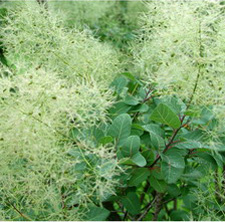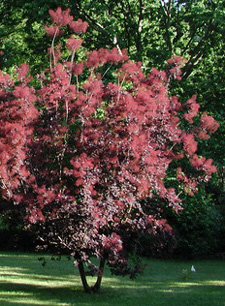Resource Library
Plant of the Week: Smokebush
The University of Arkansas System Division of Agriculture does not promote, support or recommend plants featured in "Plant of the Week." Please consult your local Extension office for plants suitable for your region.
Plant of the Week
Smokebush
Latin: Cotinus coggygria

There are a number of small specimen trees worth growing in the landscape. Springtime is the peak season for most, but a few such as the purple smokebush (Cotinus coggygria), strut their stuff in early summer. Spreading the grandeur of the garden later in the season keeps interest alive as temperatures begin to rise.
Smokebush - also sometimes called smoketree - is a large shrub or small tree growing to 20 feet tall and 10 to 15 feet wide. It's a member of the sumac family native to southern Europe and Central Asia to the Himalayas. It's an old timey shrub having been grown in English gardens since the middle years of the 16th century.
Most smokebushes grow as multi-trunked trees with main trunks cloaked in fish-scale bark that adds an interesting texture to the wintertime garden. Leaves are 3 inches long, rounded in outline and borne on a long petiole.
Most smokebushes offered in the nursery trade today are vegetatively propagated so the dark maroon or purple-leafed forms are all you see. 'Black Velvet,' Red Beauty,' 'Royal Purple' and 'Velvet Cloak' are common examples. In 2002, a yellow-leafed selection was patented called 'Golden Spirit.' In older gardens sometimes you will find a green leafed smokebush.
Smokebushes want to be trees, but flowers get in the way. In late spring and early summer, panicles of purple or white blooms are produces in a misty kind of inflorescence at the ends of the branches. The flowers stop upward growth of the stem so buds lower down on the branch then begin growing. This growth pattern tends to keep plant size down and give the tree a brushy look.

In truth, the flowers on smokebush aren't very showy. The showy portions of the inflorescence are the hairy outgrowths on the peduncles of the blooms. While the yellow, five-petaled flowers are only present a few days, the hairy panicles - sometimes a foot or more in length - go through a series of color changes and persist for several months. At the peak of showiness the gauzy panicles cloak the trees in a cloud that looks like smoke.
Usually smokebush is grown as a stand-alone specimen in the landscape where it serves as a focal point in the overall garden design. Because of their tendency to produce too many branches and have multiple growing points, smokebushes need a helping hand with a bit of careful springtime pruning. Train them to one to three trunks and limb up the branches on the lower half of the tree. Remove shoots that cross over through the canopy of the tree and generally sculpt the tree to an eye pleasing form. Prune in early spring just before new growth starts.
In Europe, smokebushes are often grown as a coppice tree with the entire plant cut back to 2- to 4-inch stubs each spring before new growth starts. This coppicing treatment eliminates flowers but produces a waist high bush with large, colorful leaves that are much more deeply colored than unpruned plants.
Smokebushes are hardy from zones 4 through 8. It is best with six hours or more of direct sunshine but will grow in light shade. In nature they are oftentimes found on limey cliffs with a high soil pH, but the tree is very adaptable and grows equally well on acidic soils. Once established it is extremely drought tolerant. It is not bothered by any serious insect or disease problems.
By: Gerald Klingaman, retired
Extension Horticulturist - Ornamentals
Extension News - August 3, 2007
The University of Arkansas System Division of Agriculture does not maintain lists of retail outlets where these plants can be purchased. Please check your local nursery or other retail outlets to ask about the availability of these plants for your growing area.